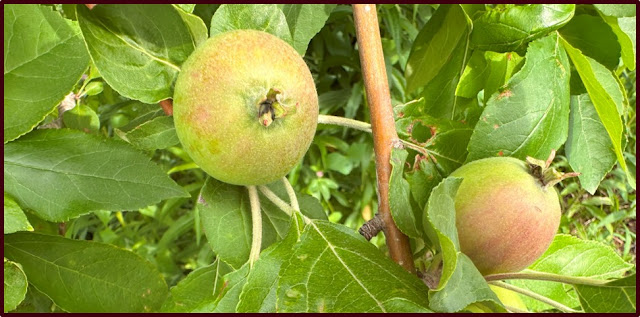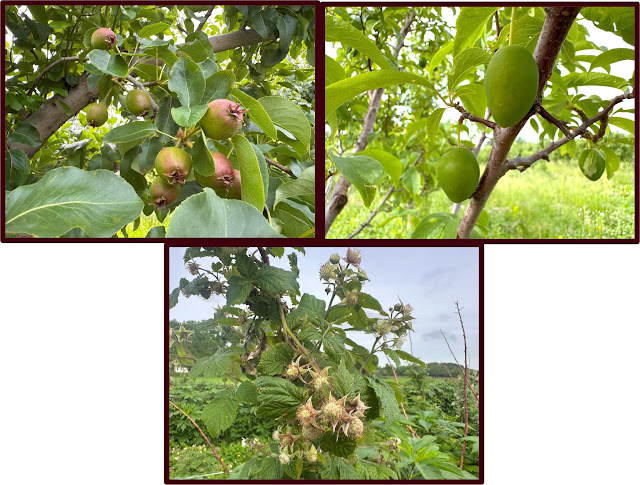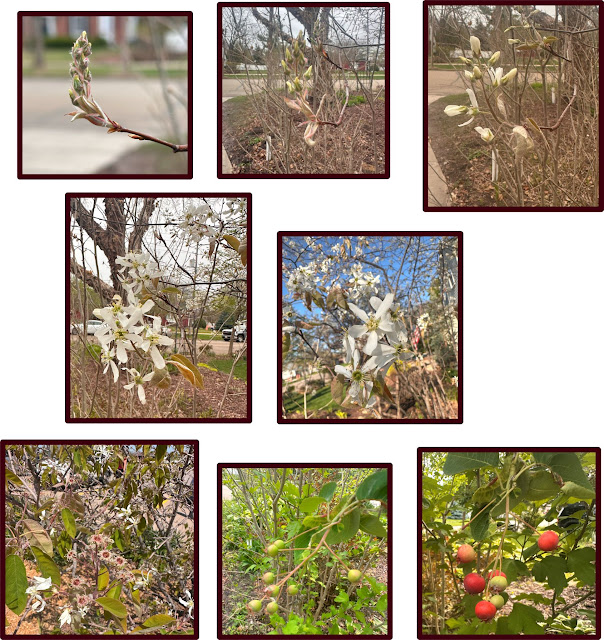Madeline Wimmer-UMN Extension Fruit Production Extension Educator

Image: Zestar grown on a semi-dwarf central leader trained tree with the largest fruits measuring around 40 mm at their widest point. Photo taken at Sekapp Orchard in Olmsted County (Zone 5a).
Apple fruits in southeastern Minnesota range from 25–40 mm at their widest points, with vegetative shoots continuing to grow and fill out the tree canopies.
In the Upper Midwest, apples at this stage are still vulnerable to secondary apple scab (Venturia inaequalis) infections, especially in orchards where primary scab became an issue. Primary insect pests that can be present include plum curculio (Conotrachelus nenuphar) and codling moth (Cydia pomonella).
Other secondary, or site-specific pests may also occasionally present and can also be monitored. This includes pests like aphids, mites, dogwood borers, and other lepidopteran/moth pests like lesser appleworm, and the red- and oblique banded leafrollers (RBLR and OBLR; Argyrotaenia velutinana and Choristoneura rosaceana).
Many of these additional pests are site specific and management decisions should be made based on pest observations through trapping or field scouting. For example, last week’s Minnesota Department of Agriculture (MDA) Fruit IPM Update shared trap reports that caught RBLR at an orchard in Carlton, Scott, and Washington counties (one of four orchards), but none in Morrison, Nobles, or Wabasha counties.
For relevant information related to pest management at this stage, refer to the Midwest Fruit Pest Management Guide section, “Apple first and second cover,” beginning on page 31.
 Image: A central leader-trained, free-standing apple tree that began to leaf out, bloom, and then began to die back. This particular site orchard had a mixture of trees that had died back and others that grew without issues. Photo taken at a hobby orchard near Loretto, MN (Zone 4b).
Image: A central leader-trained, free-standing apple tree that began to leaf out, bloom, and then began to die back. This particular site orchard had a mixture of trees that had died back and others that grew without issues. Photo taken at a hobby orchard near Loretto, MN (Zone 4b).
There have been a number of external stresses in that past year that may have contributed to these conditions. The 2024 season started with frequent rainfalls, followed by statewide drought conditions, a warm fall, and winter with very little snow cover (see below).
 Image: A map showing how much less (below average; yellow, orange, reddish-orange) or more (above average; green) snowfall there was throughout Minnesota between December 1,2025, and February 28, 2025. Most regions in Minnesota received less snow on average, which was more severe in the northwest and southern regions.
Image: A map showing how much less (below average; yellow, orange, reddish-orange) or more (above average; green) snowfall there was throughout Minnesota between December 1,2025, and February 28, 2025. Most regions in Minnesota received less snow on average, which was more severe in the northwest and southern regions.
Some apple tree diseases can lead to dieback and cankers, like black rot (Botryosphaeria obtusa)—which can lead to long-term decline and eventual tree death in serious cases—and the bacterial disease fire blight (Erwinia amylovara). Additionally, abiotic factors like winter injuries can open up pathways for secondary infections by plant pathogens and lead to tree decline.
Rapid, or Sudden Apple Decline (RAD/SAD)
There has been ongoing research related to the conditions known as Rapid or Sudden Apple Decline (RAD/SAD). This condition usually relates to the graft union and rootstock shank, and may involve interactions between the rootstock and scion, along with external factors like freeze and thaw cycles, and potential pathogen involvement.
RAD/SAD dieback symptoms tend to begin midsummer, unlike winter injury, which happens earlier in the season. While RAD/SAD is being observed more often in the Mid-Atlantic and Northwest regions of the US apple production, it's useful to be aware of in contrast to more common winter injury dieback.
Maintaining irrigation when drought conditions are present can help trees enter dormancy in better condition. However, many factors beyond management practices can still put trees at risk of winter injury, including a tree's depth of dormancy, regional weather patterns, and site specific conditions like soil type, ground cover, and overall topography and surroundings (i.e., risks from cold traps from wooded edges or low spots).
Apple trees and other fruit crops do go through sequential stages of dormancy: acclimation, deep dormancy (endodormancy), followed by a light dormancy (ecodormancy) and deacclimation. Still, trees can also become slightly more or less hardy based on winter temperatures, depending on the timing and the duration of the temperature exposure.
References:
Rapid or sudden apple decline (RAD/SAD) - Webinar (UW-Madison and UMN Extension)
Midwest Fruit Pest Management Guide
 Image: A strawberry plant showing the earliest ripening, and largest strawberry (king berry) and other strawberries in various stages of ripening. Photo taken at Sekapp Orchard in Olmsted County (Zone 5a).
Image: A strawberry plant showing the earliest ripening, and largest strawberry (king berry) and other strawberries in various stages of ripening. Photo taken at Sekapp Orchard in Olmsted County (Zone 5a).
We’re growing into that time of the year when June-bearing strawberries begin to enter local markets and farm stands, and U-Pick operations are also opening for their season.
June-bearing strawberries are biologically known as “short day” plants, meaning they set, or initiate their fruiting buds for the following season in late summer to early fall, when the daylength falls below 14 hours. This is why field renovation and drought care can make an impact on next season’s yield.
Keep in mind that renovation is not done in day-neutral strawberries, which produce fruit until the end of the season, and mowing is unnecessary during the planting year for June-bearing strawberries.
Some USDA Organic and IPM practices can also be found in the Organic production and IPM guide for strawberries from Cornell University, although readers should take note this publication was last updated in 2016, and be aware of local regulations.
References:


Thank you to our farm and ag professional partners for contributions to the UMN Fruit Update series. Unless otherwise credited, photos were taken by Madeline Wimmer or sourced from the UMN Extension system.
This article may be shared for educational purposes with attribution to the University of Minnesota Extension. For other uses, please contact UMN Extension for permission.
Apples:
- Growth stage: Apple fruits ranging from 25–40 mm wide
- Whole apple tree dieback
June-bearing strawberries:
In the meantime, previous issues remain available for reference, along with the Midwest Fruit Pest Management Guide and the UMN Extension website for fruit farming and general fruit growing.
Madeline Wimmer
- Growth stage update: Fruit ripening and harvest
- Planning for field renovation and care during late-season dry spells
- Note on strawberry pest management resources
- Growth stage highlights
- Pears, plums, and summer-bearing raspberries
- Serviceberries from budbreak to harvest
Note to readers:
This is the 9th fruit update of the season—can you believe it!? The newsletter will be on pause next week, with the next update planned for the following week.In the meantime, previous issues remain available for reference, along with the Midwest Fruit Pest Management Guide and the UMN Extension website for fruit farming and general fruit growing.
Madeline Wimmer
UMN Extension Fruit Production Educator
Apples:
Growth stage update: Apple fruits ranging from 25–40 mm wide
Image: Zestar grown on a semi-dwarf central leader trained tree with the largest fruits measuring around 40 mm at their widest point. Photo taken at Sekapp Orchard in Olmsted County (Zone 5a).
Apple fruits in southeastern Minnesota range from 25–40 mm at their widest points, with vegetative shoots continuing to grow and fill out the tree canopies.
In the Upper Midwest, apples at this stage are still vulnerable to secondary apple scab (Venturia inaequalis) infections, especially in orchards where primary scab became an issue. Primary insect pests that can be present include plum curculio (Conotrachelus nenuphar) and codling moth (Cydia pomonella).
Other secondary, or site-specific pests may also occasionally present and can also be monitored. This includes pests like aphids, mites, dogwood borers, and other lepidopteran/moth pests like lesser appleworm, and the red- and oblique banded leafrollers (RBLR and OBLR; Argyrotaenia velutinana and Choristoneura rosaceana).
Many of these additional pests are site specific and management decisions should be made based on pest observations through trapping or field scouting. For example, last week’s Minnesota Department of Agriculture (MDA) Fruit IPM Update shared trap reports that caught RBLR at an orchard in Carlton, Scott, and Washington counties (one of four orchards), but none in Morrison, Nobles, or Wabasha counties.
For relevant information related to pest management at this stage, refer to the Midwest Fruit Pest Management Guide section, “Apple first and second cover,” beginning on page 31.
Whole apple tree dieback
Reports from several areas in Minnesota have described incidents where apple trees that either failed to break bud or trees that died back after bud break. These symptoms can result from one or multiple contributing factors.There have been a number of external stresses in that past year that may have contributed to these conditions. The 2024 season started with frequent rainfalls, followed by statewide drought conditions, a warm fall, and winter with very little snow cover (see below).
Some apple tree diseases can lead to dieback and cankers, like black rot (Botryosphaeria obtusa)—which can lead to long-term decline and eventual tree death in serious cases—and the bacterial disease fire blight (Erwinia amylovara). Additionally, abiotic factors like winter injuries can open up pathways for secondary infections by plant pathogens and lead to tree decline.
Rapid, or Sudden Apple Decline (RAD/SAD)
There has been ongoing research related to the conditions known as Rapid or Sudden Apple Decline (RAD/SAD). This condition usually relates to the graft union and rootstock shank, and may involve interactions between the rootstock and scion, along with external factors like freeze and thaw cycles, and potential pathogen involvement.
RAD/SAD dieback symptoms tend to begin midsummer, unlike winter injury, which happens earlier in the season. While RAD/SAD is being observed more often in the Mid-Atlantic and Northwest regions of the US apple production, it's useful to be aware of in contrast to more common winter injury dieback.
Maintaining irrigation when drought conditions are present can help trees enter dormancy in better condition. However, many factors beyond management practices can still put trees at risk of winter injury, including a tree's depth of dormancy, regional weather patterns, and site specific conditions like soil type, ground cover, and overall topography and surroundings (i.e., risks from cold traps from wooded edges or low spots).
Apple trees and other fruit crops do go through sequential stages of dormancy: acclimation, deep dormancy (endodormancy), followed by a light dormancy (ecodormancy) and deacclimation. Still, trees can also become slightly more or less hardy based on winter temperatures, depending on the timing and the duration of the temperature exposure.
References:
Rapid or sudden apple decline (RAD/SAD) - Webinar (UW-Madison and UMN Extension)
Midwest Fruit Pest Management Guide
June-bearing strawberries
Growth stage update: Fruit ripening and harvest
We’re growing into that time of the year when June-bearing strawberries begin to enter local markets and farm stands, and U-Pick operations are also opening for their season.
Planning for field renovation and care during late-season dry spells:
June-bearing strawberries have a defined harvest window that goes from mid-June into July, depending on the growing region. After harvests have finished, strawberry field renovation can be done. This may include irrigating, fertilizing, keeping up with weeding as needed, cultivating in between rows, and mowing strawberry canopies above their crowns.June-bearing strawberries are biologically known as “short day” plants, meaning they set, or initiate their fruiting buds for the following season in late summer to early fall, when the daylength falls below 14 hours. This is why field renovation and drought care can make an impact on next season’s yield.
Keep in mind that renovation is not done in day-neutral strawberries, which produce fruit until the end of the season, and mowing is unnecessary during the planting year for June-bearing strawberries.
Note on strawberry pest management resources:
For more support related to insect pest and disease management for June-bearing strawberries, refer to the Midwest Fruit Pest Management Guide starting on page 224. For information on disease resistant cultivars, refer to page 241, and herbicide recommendations on 270.Some USDA Organic and IPM practices can also be found in the Organic production and IPM guide for strawberries from Cornell University, although readers should take note this publication was last updated in 2016, and be aware of local regulations.
References:
- Strawberry end of season renovation (UMN Extension)
- Strawberry fruit bud development (Purdue University)
- Key times for strawberry irrigation-Late summer/Fall fruit bud growth (Manitoba Ministry of Agriculture)
Additional fruit crops:
Growth stage photo highlights
Pears, plums, and summer-bearing raspberries
Images: Pears (likely Patton or Parker) are around 30 mm at their widest point (upper left). Alderman plums are averaging 24 mm at their widest point (upper right). Summer-bearing raspberries are setting fruit and continuing to develop (likely Boyne or Purple Royal). Photos taken at Sekapp Orchard in Olmsted County (Zone 5a).
Serviceberries from budbreak to harvest
Images: Serviceberry growth stages from 04/23–06/17: initial budbreak (top left), floral buds visible (top center), petals unfolding (top right), full bloom (center left), late bloom (center right), petal fall (lower left), early fruit ripening (lower center), and late fruit ripening/early harvest (lower right). Photos taken at a residential neighborhood in southeastern Minnesota (Zone 5a).
Thank you to our farm and ag professional partners for contributions to the UMN Fruit Update series. Unless otherwise credited, photos were taken by Madeline Wimmer or sourced from the UMN Extension system.
This article may be shared for educational purposes with attribution to the University of Minnesota Extension. For other uses, please contact UMN Extension for permission.
Comments
Post a Comment